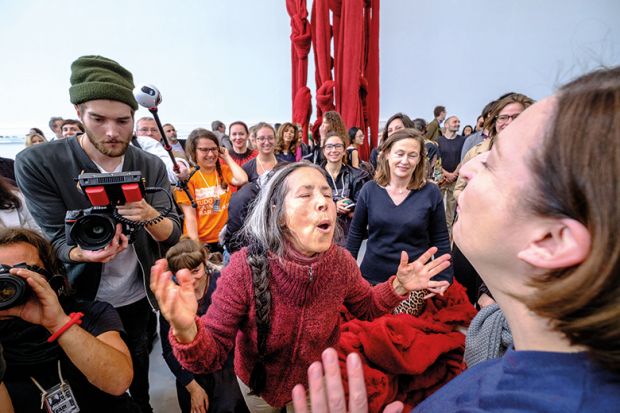With the needle or the crochet hook,” observes Simone de Beauvoir in The Second Sex, “woman sadly weaves the very nothingness of her days.” Julia Bryan-Wilson cites de Beauvoir early on in her book, acknowledging the struggle to reclaim textiles, handicrafts and the decorative arts as work of critical interest and political resistance rather than signs of an oppressed feminine domesticity. The difficulty, she notes, is that textiles can be both the carrier of traditional histories and the mode of a subversive critique.
Fray attempts to understand the politics of textile culture, drawing from an array of cultural theory and examining a selection of artefacts. The choices are esoteric and interesting: the costumes made by a queer theatrical troupe in San Francisco, traditional Chilean knotting arts deployed by a contemporary artist and the decorative quilts constructed to memorialise Aids victims in the 1980s.
These diverse sources make for an idiosyncratic book, but Bryan-Wilson works hard to piece together a broader thesis about neglected histories (often queer, non-white and feminine) and the thin seam that divides conventional handicrafts from the fine arts. She begins with the story of the charmingly titled “Ladies’ Sewing Circle and Terrorist Society”, a small feminist consciousness-raising group based in Eugene, Oregon, whose mischievous name and anodyne mock-Celtic floral logo was popularly festooned on T-shirts, mugs and buttons.
Taking the logo as a starting point, Bryan-Wilson asks: “What does it mean to imagine the sewing needle as a dangerous tool and… female collective textile making as a process that might upend conventions, threaten state structures or wreak political havoc?” It is itself a brilliantly surprising question and one that she pursues with great seriousness, setting contemporary art history against a robust material culture framework.
One of the book’s strengths is how capably it braids together these different theorisations. From Roland Barthes, Bryan-Wilson derives a conception of frayed textual meaning; the shared etymological roots of textiles and text (from the Latin texere), she says, signal something that is “at once interwoven and unfinished”. From Susan Sontag, it is the notion of “camp” and its “certain mode of aestheticism” that destabilises ordinary functionality and inverts good and bad taste. This provides a handle on how to read the queer costumes of a counter-cultural theatrical troupe from the 1970s called The Cockettes and Angels of Light. Handcrafting outfits, she says, allows for a “new conception of ownership” and redefines the boundaries of the body.
More unusual, perhaps, is Bryan-Wilson’s reading of the “social fabric of Chile”. This she explores through quipu (traditional Andean cord knotting) in the work of textile artist Cecilia Vicuña, and the thousands of Chilean arpilleras (patchwork pictures) crafted by groups of women during Augusto Pinochet’s military dictatorship. The arpilleras, in particular, are remarkable artefacts of political critique, but the author also recognises them as art, counterpoising them to Marcel Duchamp’s ready-mades.
Of the title of this unusual and interesting book, Bryan-Wilson notes that “nerves and tempers fray”. We even like to “rise above the fray”, but this is a book that immerses itself in the material expression of political and cultural life, examining the things we make and the ideas that they unravel.
Shahidha Bari is senior lecturer in Romanticism at Queen Mary University of London and fellow of the Forum for European Philosophy at the London School of Economics. She is currently writing a book on the philosophy of dress.
Fray: Art and Textile Politics
By Julia Bryan-Wilson
University of Chicago Press
296pp, £41.50
ISBN 9780226077819
Published 8 December 2017
Register to continue
Why register?
- Registration is free and only takes a moment
- Once registered, you can read 3 articles a month
- Sign up for our newsletter
Subscribe
Or subscribe for unlimited access to:
- Unlimited access to news, views, insights & reviews
- Digital editions
- Digital access to THE’s university and college rankings analysis
Already registered or a current subscriber? Login








